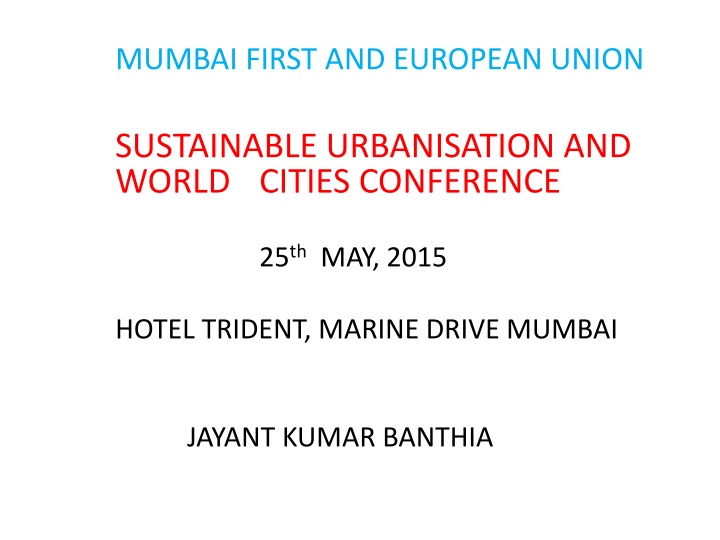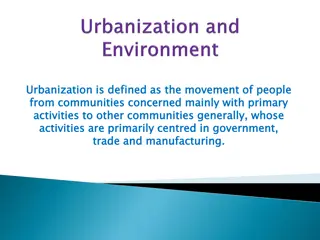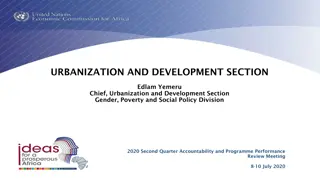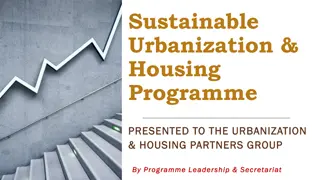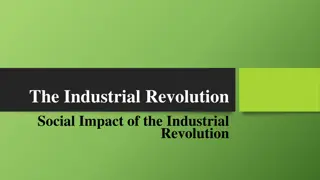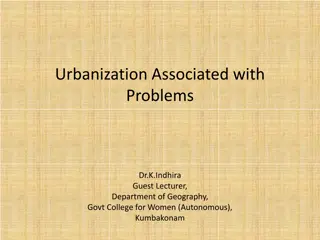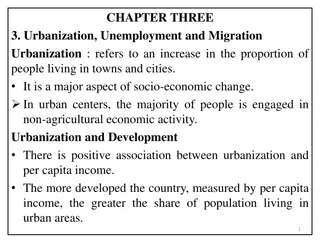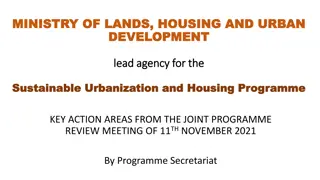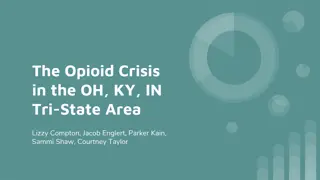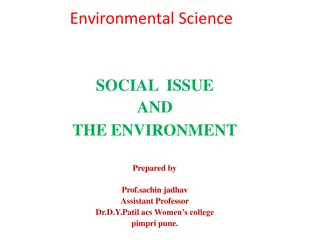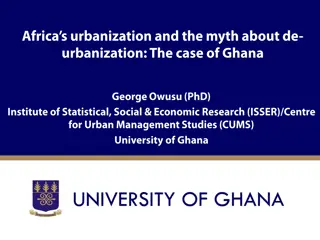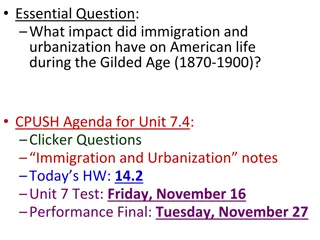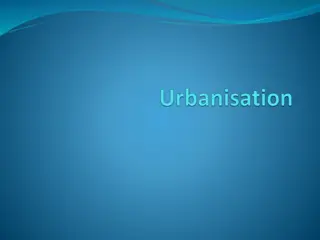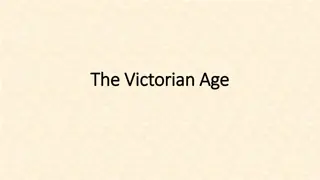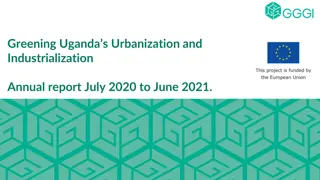Urbanization in India: Trends and Challenges
The urban population in India has seen significant growth over the years, reaching 31.30% in 2011. However, urbanization in India faces challenges such as lopsided growth, lack of industrialization, and issues with rural-urban migration. Despite this, India has a dispersed urban population, with various urban centers playing a significant role. The top 20 urban agglomerations/cities in India showcase the diverse urban landscape of the country.
Download Presentation

Please find below an Image/Link to download the presentation.
The content on the website is provided AS IS for your information and personal use only. It may not be sold, licensed, or shared on other websites without obtaining consent from the author.If you encounter any issues during the download, it is possible that the publisher has removed the file from their server.
You are allowed to download the files provided on this website for personal or commercial use, subject to the condition that they are used lawfully. All files are the property of their respective owners.
The content on the website is provided AS IS for your information and personal use only. It may not be sold, licensed, or shared on other websites without obtaining consent from the author.
E N D
Presentation Transcript
MUMBAI FIRST AND EUROPEAN UNION SUSTAINABLE URBANISATION AND WORLD CITIES CONFERENCE 25thMAY, 2015 HOTEL TRIDENT, MARINE DRIVE MUMBAI JAYANT KUMAR BANTHIA
Urban population (% of total) in India was 31.30 as of 2011. Its highest value over the past 51 years was 31.30 in 2011, while its lowest value was 17.92 in 1960. The value for Urban population in India was 388,524,900 as of 2011. Over the past 51 years this indicator reached a maximum value of 388,524,900 in 2011 and a minimum value of 80,271,580 in 1960. Definition: Urban population refers to people living in urban areas as defined by national statistical offices. It is calculated using World Bank population estimates and urban ratios from the United Nations World Urbanization Prospects.
CURRENT URBAN POPULATION OF INDIA IS APPROXIMATELY EQUAL TO INDIA S POPULATION AT THE TIME OF INDEPENDENCE AND ALSO ALMOST EQUAL TO CURRENT USA S POPULATION UNLIKE SEVERAL OTHER COUNTRIES WHICH HAVE ONE PRIMA URBAS, USUALLY THE COUNTRY CAPITAL ACCOUNTING FOR THE BULK OF THE URBAN POPULATION OF THAT COUNTRY. INDIA HISTORICALLY HAD SEVERAL URBAN CENTERS, USUALLY COASTAL CITIES. NO LONGER TRUE NOW. HENCE URBAN POPULATION IN INDIA IS CONSIDERABLY SPREAD ALL OVER THE COUNTRY.
Basic feature of urbanization in India can be highlighted as : 1 Lopsided urbanization induces growth of class I cities 2 Urbanisation occurs without industrialization and strong economic base 3 Urbanisation mainly a product of demographic explosion and poverty induced rural - urban migration. 4 Rapid urbanization leads to massive growth of slum followed by misery, poverty, unemployment, exploitation, inequalities, degradation in the quality of urban life. 5 Urbanisation occurs not due to urban pull but due to rural push. 6 Poor quality of rural-urban migration leads to poor quality of urbanization. 7 Distress migration initiates urban decay
Top 20 Urban Agglomerations/Cities in India (Census 2011) Agglomerations / Cities Agglomerations /Cities Rank State Population Rank State Population 1 Mumbai Maharashtra 18,414,288 11 Kanpur Uttar Pradesh 2,920,067 2 Delhi Delhi 16,314,838 12 Lucknow Uttar Pradesh 2,901,474 3 Kolkata West Bengal 14,112,536 13 Nagpur Maharashtra 2,497,777 4 Chennai Tamil Nadu 8,696,010 14 Ghaziabad Uttar Pradesh Madhya Pradesh 2,358,525 5 Bangalore Karnataka 8,499,399 15 Indore 2,167,447 6 Hyderabad Andhra Pradesh 7,749,334 16 Coimbatore Tamil Nadu 2,151,466 7 Ahmedabad Gujarat 6,240,201 17 Kochi Kerala 2,117,990 8 Pune Maharashtra 5,049,968 18 Patna Bihar 2,046,652 9 Surat Gujarat 4,585,367 19 Kozhikode Kerala Madhya Pradesh 2,030,519 10 Jaipur Rajasthan 3,073,350 20 Bhopal 1,883,381
As per report of the population projections constituted by the National Commission on Population (2006), the urbanization in India would be 38.8% by the year 2026. According to a survey by UN State of the World Population report in 2007, by 2030, 40.76% of country's population is expected to reside in urban areas. India will lead the world's urban population surge by 2050 as per World Bank. If one fits the trend line to the data as below, one gets that India may achieve the urbanization of 39.72% by the year 2050 only, if the trend continues. Census Year 1951 1961 1971 1981 1991 2001 2011 All-India % Urban 17.29 17.97 19.91 23.08 25.49 27.81 31.16
Contrary to conventional wisdom, natural urban growth and not migration from rural areas is the major http://4.bp.blogspot.com/-hpOqFSKSqdg/T4Bj3vqY0OI/AAAAAAAAF_8/Z1xkv7-Kah0/s320/Urbanization+1.png cause of urban population growth.
SLUM POPULATION SLUMS AND SLUM POPULATION WERE NOT A FEATURE OF EVEN METROPOLITAN TOWNS IN PRE INDEPENDENT INDIA AND ALMOST UPTO 1970 S. IMPROVEMENT TRUSTS SET UP IN PREINDEPENDENT INDIA TOOK CARE OF EMERGING URBAN PLANNING AND URBAN CHALLENGES .( NAGPUR IMPROVEMENT TRUS, BOMBAY IMPROVEMENT TRUST FOR EXAMPLE) PROVIDED HOUSING STOCK TO INDUSTRIAL URBAN MIGRANTS (CHAWLS IN MUMBAI FOR EXAMPLE PROVIDED HOUSING STOCK TO TEXTILE WORKERS)
SLUM POPULATION INTRODUCTION OF URBAN LAND CEILING ACT LED TO SEVERE LAND CRUNCH IN METROPOLITAN TOWNS AND ACCELERATED THE GROWTH OF SLUM AND SLUM POPULATION INABILITY OF LOCAL, STATE AND CENTRAL GOVERNMENTS TO PROTECT ITS OWN LAND FROM ENCROACHMENTS LED TO CREATION OF LARGE POLITICAL CONSTITUENCIES WHICH HAVE NOW BECOME AN ALBATROSS AROUND ITS NECK
Some of the major problems of urbanisation in India are 1. Urban Sprawl 2. Overcrowding 3. Housing 4. Unemployment 5. Slums and Squatter Settlements 6. Transport 7. Water 8. Sewerage Problems 9. Trash Disposal 10. Urban Crimes 11. Problem of Urban Pollution!
The Census of India 2001 concluded the first ever and the largest survey of household amenities and assets which points a never-before profile of problem relating to housing in India. The outcome is both instructive and amusing. Thirty-nine per cent of all married couples in India (about 86 million) do not have an independent room to themselves. As many as 35 per cent (18.9 million) urban families live in one-room houses.
For about a third of urban Indian families, a house does not include a kitchen, a bathroom, a toilet and in many cases there is no power and water supply. Only 79 per cent (42.6 million) urban household live in permanent (pucca/ DURABLE) houses. 67 per cent (36 million) of the urban houses are owned by the households while 29 per cent (15 million) are rented.
Mumbai draws water from neighbouring areas and from sources located as far as 125 km in the Western Ghats. Chennai uses water express trains to meets its growing demand for water. Bangalore is located on the plateau and draws water from Cauvery river at a distance of 100 km. Water for Bangalore has to be lifted about 700 metres with help of lifting pumps. Hyderabad depends on Nagarjuna Sagar located 137 km away. Delhi meets large part of its water requirements from Tajiwala in Haryana. Water is also drawn from Ramganga as far as 180 km.
Almost all the major programmes of urban development suffer from the chronic disease of resource crunch. Urban Development has been low on the development agenda with only 3-4 per cent of the total plan outlay being allocated to the urban sector. The National Commission on Urbanization recommended in 1988 that at least 8 per cent of the Plan outlay should be dedicated to urban sector.
Despite the increasing importance of cities, urban development remains someway off from the mainstream development radar. The graphic below accurately captures the development priorities of Government of India. The Eleventh Plan (2007-12) allocation to various sectors reveals the low priority for urban development.
http://2.bp.blogspot.com/-UZSeXlpWcww/T4BnZGkYwTI/AAAAAAAAGAE/ukDuqt1aV8c/s320/Urbanization+2.pnghttp://2.bp.blogspot.com/-UZSeXlpWcww/T4BnZGkYwTI/AAAAAAAAGAE/ukDuqt1aV8c/s320/Urbanization+2.png
CHALLENGES IN URBAN GOVERNANCE LACK OF GOOD TOWN PLANNERS AND URBAN ADMINISTRATORS LACK OF EXPOSURE TO URBAN GOVERNANCE AS A PART OF DISTRICT TRAINING AND INITIAL CAREER PLANNING FOR THE INDIAN ADMINISTRATIVE OFFICERS(IAS) URBAN LOCAL BODIES UNABLE TO PROVIDE ELECTED REPRESENTATIVES (CORPORATORS) WHO CONVERT AND EMERGE AS RELEVANT LEGISLATIVE ASSEMBLY MEMBERS ( MLA S) OR MEMBER OF PARLIAMENT (MP S) FOR RAISING URBAN ISSUES
CHALLENGES IN URBAN GOVERNANCE AS RESULT THE MINISTER IN CHARGE OF URBAN AFFAIRS IN UNION AND STATE GOVERNMENTS HAVE LITTLE PRIOR EXPOSURE AND EXPERIENCE OF URBAN ISSUES FREEZING OF THE CONSTITUENCY BOUNDARIES FOR THE MLA S AND MP S BASED ON 1971 CENSUS URBAN/ RURAL POPULATION DISTRIBUTION LED TO POOR AND DISTORTED UNDER-REPRESENTATION OF THE URBAN POPULATION AND URBAN ISSUES, UNTIL 2005 . A FRESH DELIMITATION OF THE BOUNDARIES TOOK PLACE BASED ON THE 2001 CENSUS TO PROVIDE FOR PROPORTIONATE REPRESENTATION OF URBAN POPULATION
THANKS FOR YOUR TIME ANY Q&A ??
